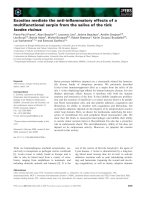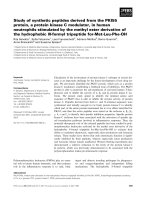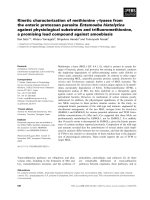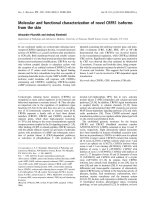GENETIC CONNECTIVITY OF FOUR MANGROVE SPECIES FROM THE MALAY PENINSULA
Bạn đang xem bản rút gọn của tài liệu. Xem và tải ngay bản đầy đủ của tài liệu tại đây (3.3 MB, 160 trang )
GENETIC CONNECTIVITY OF FOUR MANGROVE
SPECIES FROM THE MALAY PENINSULA
WEE KIM SHAN
B.Sc. (Hons), NUS
A THESIS SUBMITTED
FOR THE DEGREE OF DOCTOR OF PHILOSOPHY
DEPARTMENT OF BIOLOGICAL SCIENCES
NATIONAL UNIVERSITY OF SINGAPORE
2013
i
Declaration
I hereby declare that this thesis is my original work and it has been written by me in its
entirety. I have duly acknowledged all the sources of information which have been used in
the thesis.
This thesis has also not been submitted for any degree in any university previously.
____________________________________
Wee Kim Shan
12 Aug 2013
ii
Acknowledgements
This research was conducted when I was in receipt of the Lee Kong Chian Graduate
Scholarship. Financial support for the research project came from the Academic Research
Fund awarded by the Singapore Ministry of Education to Associate Professor Edward Webb
(grant number R154-000-440-112).
Field work was carried out under the Singapore NParks permit number NP/RP930F and the
Thai NRCT project ID-2565 “Ecology and Hydrodynamics of Mangroves”. Samples from
Malaysia were collected in collaboration with Dr Mohd Nazre Bin Saleh from Universiti
Putra Malaysia. Part of the Rhizophora mucronata samples included in Chapter 5 was
obtained from the Research Network for Conservation Genetics of Mangroves.
I particularly wish to thank my supervisor, Associate Professor Edward Webb, who initiated
this project, secured the funding and has always been nothing but supportive and
encouraging. Thank you for taking on this clueless novice and tirelessly nurture her into a
confident researcher. I cannot wish for a better academic father. I hope I have made you
proud.
To Dr Annika Noreen, my dear mentor, I look up to you like Evelyn Forbes to Amelia
Peabody. Thank you for your unfailing support, both in science and in life, especially during
the treacherous last months of thesis-writing. You have been a pillar of strength and I cherish
your companionship immensely.
Associate Professor Tadashi Kajita and Dr Koji Takayama provided invaluable mentorship
and assistance throughout the duration of my PhD. Thank you for the invitation to join the
Exchange Program for Conservation Genetics of Mangroves funded by JSPS JENESYS
Programme in 2009 and 2011, from which many important collaborations have been forged.
iii
I would also like to thank my thesis committee members, Prof Prakash Kumar, Prof Richard
Corlett and Associate Professor Hugh Tan who have been very generous with their advice
and knowledge.
To my extended family in the Applied Plant Ecology Lab, thanks for making these four years
such a pleasant journey. I am indebted to Jasher Chua for his assistance in the molecular
work. Jack, thanks for being a trooper, you are the best at the job. I am grateful to Assistant
Professor Daniel Friess for his mentorship throughout the years. Of course, my dear past and
present APE labbers: Jacob Phelps, Rachel Oh, Leong Chin Rick, Anuj Jain, Matti Nissalo,
Grace Blackham, Enoka Priyadarshani, Becky Chen Shu, Wang Yi and Demis Galli, Low
See Yan, Yu Inutsuka, Chrisopher Zieber, Kyra Zhang Xiaoqing , Junya Ono and Yoshimi
Shinmura, you are a wonderful lot. I am truly blessed to be part of this family.
Several people assisted me with field work abroad. I especially thank Latifah Zainal Abidin,
Dr Chanyut Sudtongkong, Erik Horstman, Thorsten Balke, Eva Van Den Elzen, Martijn
Siemerink, Niels-Jasper van den Berg, Siti Eryani Suterisno and Shaharuddin Md Isa. Thank
you for making field sampling a treasured memory.
I wish to thank Dr Tay Ywee Chieh for her companionship and support in genetic analysis,
Dr Bijoy Thompson from the Tropical Marine Science Institute for performing the ocean
circulation simulation; and my collaborators in Belgium, Tom Van der Stocken, Dennis de
Ryck, Professor Farid Dahdouh-Guebas and Professor Nico Koedam for the discussion on the
literature review.
I thank the members of the Plant Systematics Lab (Chiba University), Plant Morphogenesis
Lab (NUS) and Plant Systematics Lab (NUS) for the much valued camaraderie and support.
iv
Last but not least, I want to dedicate this thesis to my loving parents and aunt, who have been
with me every step of the way. Thanks for believing in me and supporting me along this
“path less travelled”. It has brought me to the most beautiful places and I’m glad I could
share the marvelous view with you.
v
Table of Contents
Declaration……………………………………………………………………………… i
Acknowledgement……………………………………………………………………… ii
Summary……………………………………………………………………………… viii
List of tables…………………………………………………………………………… xi
List of figures………………………………………………………………………… xii
Chapter 1: Thesis introduction…………………………………………………………. 1
1.1 Mangroves: importance and threats………………………………………………… 1
1.2 Genetic connectivity in mangroves………………………………………………… 2
1.3 Key factors of gene flow in mangroves…………………………………………… 4
1.3.1 Reproductive traits……………………………………………………………… 4
1.3.2 Land barriers……………………………………………………………………… 5
1.3.3 Ocean currents……………………………………………………………………. 6
1.3.4 Interactions among the factors……………………………………………………. 7
1.4 Study site……………………………………………………………………………. 8
1.5 Study species………………………………………………………………………. 10
1.6 Thesis aims and objectives…………………………………………………………. 12
1.7 Overview of chapters………………………………………………………………. 12
Chapter 2: Microsatellite marker development for Avicennia alba, Sonneratia alba and
Rhizophora mucronata………………………………………………………………… 14
2.1 Introduction………………………………………………………………………… 14
2.2 Materials and methods……………………………………………………………… 15
2.3 Results and discussion……………………………………………………………… 17
2.4 Conclusion………………………………………………………………………… 21
Chapter 3: The reproductive traits, dispersal potentials and their influence on gene flow: A
review………………………………………………………………………………… 22
3.1 Introduction………………………………………………………………………… 22
3.2 General reproductive traits of the study species…………………………………… 23
3.3 Importance of pollen versus propagule to gene flow……………………………… 27
3.4 Conceptual framework for gene flow in mangroves………………………………. 29
3.5 Pollen dispersal…………………………………………………………………… 30
3.5.1 Pollinator mobility……………………………………………………………… 31
3.5.2 Pollinator abundance and diversity………………………………………………. 32
3.6 Propagule production………………………………………………………………. 33
3.6.1 Fecundity………………………………………………………………………… 34
3.6.2 Phenology………………………………………………………………………… 35
3.7 Propagule dispersal………………………………………………………………… 36
3.7.1 Initiation of dispersal……………………………………………………………… 36
3.7.1.1 Tidal flushing…………………………………………………………………… 37
3.7.1.2 Retention……………………………………………………………………… 38
vi
3.7.2 Transport…………………………………………………………………………. 38
3.7.2.1 Flotation……………………………………………………………………… 38
3.7.2.2 Hydrodynamics…………………………………………………………………. 39
3.7.3 Termination of dispersal………………………………………………………… 40
3.7.3.1 Stranding……………………………………………………………………… 40
3.7.3.2 Obligate dispersal period………………………………………………………. 41
3.7.3.3 Viability…………………………………………………………………………. 41
3.8 Establishment………………………………………………………………………. 42
3.9 Summary: predicted implications of relative gene dispersal potential on genetic
connectivity…………………………………………………………………………… 43
3.10 Conclusion………………………………………………………………………… 46
Chapter 4: Congruence between propagule dispersal potential and genetic connectivity in
four mangrove species…………………………………………………………………. 48
4.1 Introduction…………………………………………………………………………. 48
4.2 Materials and methods……………………………………………………………… 52
4.2.1 Population sampling and genotyping…………………………………………… 52
4.2.2 Genetic data quality………………………………………………………………. 55
4.2.3 Basic genetic parameters: diversity and differentiation………………………… 56
4.2.4 Genetic structure across the MP………………………………………………… 56
4.2.5 Genetic connectivity within coasts……………………………………………… 58
4.3 Results……………………………………………………………………………… 60
4.3.1 Data quality………………………………………………………………………. 60
4.3.2 Basic genetic parameters: diversity and differentiation………………………… 61
4.3.4 Genetic structure across the MP………………………………………………… 63
4.3.5 Genetic connectivity within coasts……………………………………………… 69
4.4 Discussion………………………………………………………………………… 73
4.4.1 Population structure as a remnant signal of vicariance in A. alba, S. alba and B.
gymnorhiza……………………………………………………………………………… 75
4.4.2 Malay Peninsula as a biogeographic “filter” to gene flow across species……… 76
4.4.3 Genetic connectivity within coasts………………………………………………. 77
4.4.4 Influence of reproductive traits on gene flow……………………………………. 80
4.5 Conclusion………………………………………………………………………… 81
Chapter 5: Oceanic currents, not land masses, maintain the genetic structure of mangrove
Rhizophora mucronata in Southeast Asia……………………………………………… 83
5.1 Introduction…………………………………………………………………………. 83
5.2 Materials and methods……………………………………………………………… 86
5.2.1 Population sampling and genotyping…………………………………………… 86
5.2.2 Genetic data quality……………………………………………………………… 89
5.2.3 Genetic diversity………………………………………………………………… 89
5.2.4 Genetic structure…………………………………………………………………. 90
5.2.5 Hypothesis testing………………………………………………………………… 91
5.3 Results……………………………………………………………………………… 92
vii
5.3.1 Data quality……………………………………………………………………… 92
5.3.2 Genetic diversity…………………………………………………………………. 93
5.3.3 Genetic structure…………………………………………………………………. 94
5.3.4 Hypothesis 1 and 2: Simple Mantel tests………………………………………… 96
5.3.5 Hypothesis 3: Ocean surface simulation………………………………………… 97
5.4 Discussion………………………………………………………………………… 101
5.4.1 Low genetic diversity and heterozygosity of R. mucronata………………………. 101
5.4.2 Absence of IBD and an east-west genetic differentiation across the MP………… 102
5.4.3 Ocean currents driving population subdivision………………………………… 103
5.5 Conclusions………………………………………………………………………… 106
Chapter 6: Thesis synthesis……………………………………………………………. 107
6.1 Introduction………………………………………………………………………… 107
6.2 Propagule dispersal as the main mechanism of gene flow among populations……. 107
6.3 Mangroves as a community with restricted gene flow across populations………… 110
6.4 Historical and contemporary barriers drive genetic differentiation………………… 111
6.5 Conservation implications………………………………………………………… 113
6.7 Final conclusion……………………………………………………………………. 114
References……………………………………………………………………………… 116
Appendix……………………………………………………………………………… 137
viii
Summary
Mangroves are threatened globally by land conversion, habitat degradation and climate
change. As fragmentation and degradation continues to worsen in mangrove habitats, the
genetic connectivity among populations of mangrove species becomes increasingly important
to maintain sufficient genetic diversity and evolutionary potential. In this thesis, I determined
the effects of reproductive traits, physical barriers and ocean currents on the gene flow of
mangroves, by examining the genetic connectivity of four major mangrove species from the
Malay Peninsula (MP)—Avicennia alba, Sonneratia alba, Bruguiera gymnorhiza and
Rhizophora mucronata.
To obtain sufficient numbers of reliable DNA markers for genotyping, eleven nuclear
microsatellite markers for A. alba, S. alba and R. mucronata were developed. Reproductive
traits that may influence the gene dispersal potential of a mangrove species were assessed by
using a conceptual framework for gene flow. As gene flow can occur both via pollen and
propagule dispersal, the four study species were ranked based on their relative dispersal
potentials for pollen and propagule, respectively. Evidence gathered from the literature
revealed that S. alba and B. gymnorhiza had higher pollen dispersal potentials than A. alba
and R. mucronata due to more mobile vertebrate pollinators, while B. gymnorhiza and R.
mucronata had higher propagule dispersal potentials than A. alba and S. alba due to longer
propagule flotation period and longevity. The relative gene dispersal potentials were later
employed to examine the influence of reproductive traits on gene flow.
The effects of both physical barriers and dispersal potential on genetic connectivity were
investigated via a comparative population genetics analysis across species. First, the genetic
ix
structure across species was examined to determine the role of the MP as a physical barrier to
gene flow. Different genetic lineages were detected on each coast of the MP in A. alba, S.
alba and B. gymnorhiza despite recent hydrological connectivity across the MP that had
brought both lineages together. Strong genetic structure across the MP indicated the presence
of the remnant genetic signature from the vicariance across the MP during the last glacial
maximum. The signature of this vicariance was most prominent in A. alba and S. alba, less so
in B. gymnorhiza and undetectable in R. mucronata. The MP posed a weak barrier to gene
flow in the latter two species. Contemporary gene flow was able to re-establish connectivity
between coasts. When only genetic connectivity within coasts was considered, A. alba and S.
alba showed lower gene flow than B. gymnorhiza and R. mucronata. The relative propagule
dispersal potential across species provided a compelling explanation for the genetic pattern
observed among different species. Species with higher propagule dispersal potentials (B.
gymnorhiza and R. mucronata) consistently showed higher gene flow across a physical
barrier and along the same coastline than species with lower propagule dispersal potentials
(A. alba and S. alba). Assuming that contemporary gene flow shaped the observed genetic
patterns, it implies that the longer flotation period and viability in B. gymnorhiza and R.
mucronata enhanced their dispersal ability as compared to the other two species. Therefore,
the comparative analysis provided convincing evidence that the genetic connectivity in a
mangrove species is closely related to its propagule dispersal potential.
Among the four studied species, only R. mucronata did not show a clear genetic structure
across the MP. Therefore, a larger geographical range (adding Myanmar, Indonesia and
Vietnam) was sampled and an ocean circulation simulation was performed to understand the
influence of geographic distance, physical barrier (the MP) and ocean circulation patterns on
the genetic structure of this particular species. The results demonstrated that unlike other
mangrove species, the most prominent genetic break was not situated across the MP, but at
x
the northern section of the Malacca Strait, separating populations from Myanmar and
northern Sumatra from the others from the Malacca Strait and the South China Sea. The odd
location of the genetic discontinuity coincided with ocean circulation patterns that prevented
the mixing of waters at the boundary between Andaman Sea and the Malacca Strait, thus
supporting that gene flow of R. mucronata was maintained by ocean current-facilitated
propagule dispersal.
In summary, propagule dispersal is the main mechanism for gene flow among populations.
The data revealed that mangrove populations from the MP have strong genetic structure,
supporting the suggestion that mangroves have restricted gene flow. The genetic pattern
across the MP reflects the propagule dispersal potential of each species. Comparative analysis
across species demonstrated that the MP was a differential barrier to gene flow. Although the
genetic structure of R. mucronata showed a genetic discontinuity on the boundary of the
Andaman Sea and the Malacca Strait, implying the importance of ocean circulation patterns
in defining the genetic connectivity in this species. This thesis provided valuable insights on
the factors influencing gene flow among populations, which are useful in understanding how
increasing anthropogenic disturbances may threaten mangrove communities.
xi
List of Tables
Table 1.1. Reproductive traits of the study species………………………………………. 12
Table 2.1. Characteristics of the 11 dinucleotide microsatellite loci developed in this study
19
Table 2.2. Cross-amplification of microsatellite loci……………………………………. 20
Table 2.3. Monomorphic microsatellite loci isolated in this study.……………………… 21
Table 3.1. Comparison of pollination mechanism, breeding/mating system and propagule
traits among the four study species………………………………………………………. 26
Table 3.2. Pollen and propagule dispersal potentials of the four study species…………. 45
Table 4.1. Site information of the 12 sampling location included in this study…… 54
Table 4.2. List of microsatellite loci employed in this study……………………………. 54
Table 4.3. Genetic diversity parameters of sampled populations……………………… 62
Table 4.4. Simple Mantel test and hierarchical analysis of molecular variance for four
species, comparing populations from west and east of the Malay Peninsula…………… 65
Table 4.5. Test for difference in mean of H
E
, pairwise F
ST
and pairwise D
A
between
species……………………………………………………………………………………. 69
Table 4.6 Bayesian assessment of migration within and between populations implemented in
BAYESASS for each study species………………………………………………………. 72
Table 4.7 Summarized results from multiple genetic analyses in each of the two major
components of the study…………………………………………………………………. 74
Table 5.1. Location information of the 13 sampled populations…………………….…. 88
Table 5.2. Genetic diversity parameters of the sampled populations……………………. 94
Table 5.3. Pairwise F
ST
values between populations……………………………………. 95
xii
List of Figures
Figure 1.1. The proposed location of two major mangrove refugia (shaded orange) during the
last glacial maximum…………………………………………………………………… 11
Figure 3.1. Flowers (left) and propagules (right) of the four study species……………… 25
Figure 3.2 Conceptual framework of gene flow via pollen and propagule exchange among
populations……………………………………………………………………………… 30
Figure 3.3. Relative pollen and propagule dispersal potentials for the four study species 46
Figure 4.1. Map showing the 12 sampling locations of this study………………… 55
Figure 4.2. Individual-based PCoA scatter plots showing the extent of east-west
differentiation across the MP…………………………………………………………… 66
Figure 4.3. STRUCTURE bar plots showing the optimum number of genetic clusters (K) for
each species……………………………………………………………………………… 67
Figure 4.4. Neighbour-joining phylograms showing the genetic relationships among
populations for (A) A. alba, (B) S. alba, (C) B. gymnorhiza and (D) R. mucronata…… 68
Figure 4.5. Mantel test indicating the isolation-by-distance signal for each species among
populations from the west of the MP…………………………………………………… 71
Fig. 5.1 Maps depicting the genetic structure among populations and the ocean surface
circulations……………………………………………………………………………… 98
Fig. 5.2. Large-scale population genetic structure……………………………………… 99
Figure 6.1 Summary diagram of the level of genetic flow and location of barriers to gene
flow……………………………………………………………………………………… 107
Chapter 1 Thesis introduction
1
Chapter 1: Thesis introduction
1.1 Mangroves: importance and threats
Mangroves are widespread intertidal plants found across the world’s tropical and subtropical
regions, comprised of circa 70 species derived from different ancestral sources of terrestrial
angiosperms (Duke, 1995; Spalding et al., 2010). Mangroves provide important ecosystem
services, such as nursery ground for marine animals, wood production (Alongi, 2002), coastal
defense against storm surges (Kathiresan & Rajendran, 2005) and erosion (Thampanya et al.,
2006). Despite their enormous economic value (Alongi, 2002) mangroves are threatened
globally by land conversion, habitat degradation (Valiela et al., 2001) and climate change
(Gilman et al., 2008). The hotspot for mangrove species diversity—the Indo-Malay
Philippine Archipelago—has the highest rate of mangrove loss in recent decades, to the
extent that some species are at risk of extinction (Polidoro et al., 2010). As a result, mangrove
habitats are increasingly fragmented and degraded, at a rate equal to or greater than many
other charismatic ecosystems such as coral reefs and terrestrial tropical rainforests (Duke et
al., 2007).
Maintaining sufficient gene flow among populations in an increasingly fragmented landscape
is crucial to prevent genetic erosion (Aguilar et al., 2008). In plants, gene flow occurs via
pollen and seed dispersal. Habitat isolation often leads to reduced gene flow due to pollen
limitation (Aguilar et al., 2006) and restricted seed dispersal (Hamilton, 1999), resulting in
increased inbreeding (Cascante, 2002; Fuchs et al., 2003) and decreased genetic diversity
(Young et al., 1996; Dayanandan et al., 1999; Sebbenn et al., 2011). As offspring of related
individuals tend to have lower survivability and fertility—a process termed inbreeding
depression (see Charlesworth & Willis, 2009)—increased inbreeding may subsequently lower
Chapter 1 Thesis introduction
2
population fitness (Buza et al., 2000). In the long term, the loss of adaptive genetic variation
severely undermines the evolutionary potential of a species (Sork & Smouse, 2006).
Mangroves are highly adaptable plants, evolving in extremely dynamic and disturbed
environment at the terrestrial margins of brackish or saline waters with a wide range of tidal
regimes (Lugo & Snedaker, 1974). Mangrove communities are restricted to pockets of
sheltered intertidal environment along the coast with low hydrodynamic energy (Tomlinson,
1986). As a result, mangroves have a naturally discontinuous distribution along coastlines,
and are found in estuaries, river deltas and stretches of less-exposed coastal shores (Spalding
et al., 2010). Despite having patchy distribution, mangroves often have profuse gene flow
among distant but hydrologically connected populations, especially populations along the
same coastline (Ge & Sun, 1999; Arnaud-Haond et al., 2006).
Nevertheless, genetic erosion had been observed in degraded mangrove habitats, indicating
that the ecosystem is not immune to the disruption in gene flow following anthropogenic
disturbances. Habitat fragmentation by a highway construction resulted in increased
inbreeding and reduced allelic diversity in Avicennia germinans (Salas-Leiva et al., 2009).
These signs of genetic erosion were observed merely four decades post-disturbance, implying
that habitat fragmentation could lead to observable impacts within a short time frame. The
degree of susceptibility to fragmentation may depend on the dynamics of gene flow among
populations (Hamrick, 2004). Hence, understanding the drivers and limitations of gene flow
in threatened ecosystems is a priority in conservation agendas.
1.2 Genetic connectivity in mangroves
Genetic connectivity—defined as gene flow that alters the genetic diversity and divergence
among populations (Lowe & Allendorf, 2010)—is determined by both past and present
events of gene dispersal. Conditions which foster gene flow among groups of individuals,
Chapter 1 Thesis introduction
3
such as habitat continuity (Benzie, 1999b) and unobstructed dispersal (Leclerc et al., 2008),
enhance genetic connectivity and may even lead to panmixia (Bricker et al., 2011).
Contrarily, conditions which interrupt gene flow, such as segregated distribution (Sebbenn et
al., 2011), phenological differences (Yamagishi et al., 2005) and barriers to dispersal
(Leclerc et al., 2008), result in genetic divergence and discontinuities among populations.
Genetic connectivity can be elucidated from the genetic structure of a species, as gene flow is
one of the main contributors to population subdivision (Slatkin, 1985; Hewitt, 2001).
Genetic connectivity in mangroves is largely limited to within an oceanic region (see Triest,
2008); higher levels of gene flow occur among populations from the same oceanic region
than those from different regions (Ge & Sun, 1999; Giang et al., 2003; Liao et al., 2007;
Huang et al., 2008). This genetic pattern parallels that of other coastal or marine communities
(Barber et al., 2000; Lessios, 2008; Gaither et al., 2011), especially plants with sea-dispersed
seeds, e.g. Hibiscus tiliaceus (Takayama et al., 2006) and Zostera marina (Olsen et al.,
2004). The major cause for this congruency is that a considerable proportion of gene flow in
mangroves is water-borne. All true mangroves have water-dispersed propagules that can float
for an extended period of time in saline, brackish and fresh- water (Tomlinson, 1986; Clarke
et al., 2001). Buoyant propagules can be passively dispersed by ocean currents over long
distances (Clarke, 1993; Steinke & Ward, 2003; Nathan et al., 2008), which could lead to
frequent gene flow within areas connected by ocean currents.
High connectivity within the same oceanic region may also be a signature of shared
biogeographic history among the populations (Benzie, 1998; Triest, 2008). As an intertidal
plant community, the distribution range of mangroves follows the rise and fall of sea level.
Populations from the same oceanic regions most likely share common descent during
historical range expansion and contraction resulting from sea level fluctuation in the late
Chapter 1 Thesis introduction
4
Pleistocene and Holocene (reviewed in Hewitt, 2000). This will be further discussed in the
subsequent section on land barriers to gene flow.
1.3 Key factors of gene flow in mangroves
1.3.1 Reproductive traits
The genetic connectivity in plants is closely linked to life history and reproductive traits, such
as breeding system (Loveless & Hamrick, 1984), mating system (Procaccini et al., 2007;
Aguilar et al., 2008), pollination (Kolb & Diekmann, 2005), seed dispersal mechanism (e,g.
(Hamrick et al., 1993) and fecundity. Such traits determine the extensiveness—both in
magnitude and spatial range—of gene flow. For example, species with bird-dispersed seeds
have higher genetic connectivity and weaker genetic structure than those with wind-dispersed
seeds, perhaps due to larger distances that seeds are routinely dispersed by birds (Hamrick et
al., 1993).
Despite the recognized importance of reproductive traits to gene flow, this relationship has
not been sufficiently explored in mangroves. Although all true mangroves have sea-dispersed
propagules, the dispersal characteristics of these propagules, especially the buoyancy (e.g.
Clarke et al., 2001) and longevity (e.g. Allen & Krauss, 2006) are highly species-specific.
Furthermore, different pollination syndromes are found among mangroves, including wind-,
bird-, bats- and insect-pollination (Tomlinson, 1986). With such wide variety of reproductive
traits, the level of genetic connectivity is expected to differ across species. Although
pollination mechanisms and propagule dispersal distance have been used to explain observed
genetic structure of mangroves (e.g. Ge et al., 2003; Geng et al., 2008; Huang et al., 2008),
studies explicitly testing the effects of reproductive traits on genetic connectivity are absent.
A robust assessment of genetic connectivity requires the inclusion of species representing the
typical reproductive traits found in the ecosystem (Hughes et al., 2003). Therefore, a
Chapter 1 Thesis introduction
5
comparative study will help to elucidate the contribution of reproductive traits to gene flow in
mangroves.
1.3.2 Land barriers
Genetic discontinuities in mangroves often coincide with the presence of historical and
contemporary land barriers to gene flow (see Triest, 2008). Barriers result in a localized
reduction in pollen or seed dispersal which consequently manifest as boundaries to gene flow
among populations. Land masses are one of the most conspicuous barriers to gene flow.
Vicariance—the division of a species’ distribution range, often by land masses (Wiley,
1988)—is the precursor to important evolutionary processes such as allopatric speciation and
genetic divergence (Wiley, 1988; Benzie, 1998). The African continent, the Central
American Isthmus (CAI) and the Malay Peninsula (MP) are perhaps the most important
contemporary land barriers in mangroves (see Triest, 2008). The African continent is a key
biogeographic force in the evolution of the division in global distribution of mangroves into
two biogeographic regions: the Atlantic East Pacific (AEP) and the Indo West Pacific (IWP)
(Duke et al., 2002); whereas both the CAI and MP are strong barriers to gene flow. The CAI,
for instance, geographically separated mangrove populations from the Atlantic and the
Pacific coasts for the past three million years (Haug & Tiedemann, 1998), resulting in a deep
genetic divergence between the two groups (Dodd et al., 2002; Nettel, 2007; Takayama et al.,
2013).
Genetic discontinuities observed in the absence of a physical barrier can be explained by the
presence of a strong barrier to gene flow in the past. For example, the genetic discontinuity
between mangrove populations from the Indian and Pacific oceans (Tan et al., 2005; Su et
al., 2007; Huang et al., 2008) results from separation of populations by the Sunda and Sahul
continental shelves during glacial maximum (Flenley, 1998; Barber et al., 2000). Such strong
Chapter 1 Thesis introduction
6
genetic signature indicates that contemporary oceanic connectivity has yet to facilitate strong
genetic connectivity between both ocean basins. These historical barriers are particularly
interesting, as it allows for testing hypotheses regarding the causal relationship between
geographic phenomena and genetic connectivity (see Hickerson et al., 2010).
1.3.3 Ocean currents
As mangrove propagules are passively dispersed by sea, the extent of propagule-mediated
gene flow may depend, to a large extent, on the prevailing ocean currents. This is a
reasonable expectation, as the movement of the vector is a good predictor of dispersal
patterns and gene flow in many abiotic dispersal systems, e.g. wind-dispersed plants (Soons
et al., 2004), aquatic plants (Pollux et al., 2009) and pelagic marine larvae (Galindo et al.,
2006). Ocean currents may facilitate or impede gene flow. On the one hand, dispersal by sea
has a high potential to reach long distances (Nathan et al., 2008) and hence achieve extensive
gene flow (e.g. Uthicke & Benzie, 2003; Doonan et al., 2012). In mangroves, gene flow is
observed among populations within the same oceanic region (Ge & Sun, 1999; Giang et al.,
2003; Liao et al., 2007; Huang et al., 2008); there is even indirect evidence of historical
trans-oceanic dispersal (Dodd et al., 2002).
Although the open ocean environment provides few obvious barriers to dispersal for buoyant
larvae or propagules, the detection of strong genetic breaks within species with high dispersal
potential prompt the inference that ocean currents may act as a cryptic barrier (Barber et al.,
2002; Thornhill et al., 2008). There are two pieces of evidence of cryptic oceanic barriers in
mangroves. First, the genetic discontinuity among Rhizophora mangle populations in Brazil
(which were likely founded by the same source) is attributed to the bifurcating ocean currents
along the coast (Pil et al., 2011). A close inspection of ocean circulation patterns in the South
China Sea (Yang et al., 2002; Fang et al., 2009) revealed that this may also be the case for
Chapter 1 Thesis introduction
7
the genetic break between northern and southern Avicennia marina populations in Vietnam
(Kado et al., 2004), though it was not explicitly implied by the authors. These examples
demonstrate that certain genetic discontinuities among mangrove populations are best
explained by the ocean circulation patterns.
The advent of seascape genetics (Galindo et al., 2006)—a comparative analysis of
oceanographic and genetic models—provided new insights to the spatial ecology of marine
populations, especially in understanding dispersal potential (White et al., 2010), marine
reserve design (Selkoe et al., 2008) and the conservation of threatened species (Schultz et al.,
2008). Despite the advancement of seascape genetics in other study systems, to date the direct
comparison of ocean currents and genetic data is absent in mangroves, with the exception of
the study on Rhizophora mangle populations in Brazil (Pil et al., 2011). This remains a
knowledge gap that is yet to be addressed.
1.3.4 Interactions among the factors
In mangroves, the key factors of gene flow are reproductive traits, land barriers and ocean
currents. Contrasting but equally convincing evidence from various studies on sympatric
mangrove species shows that while land barriers and vicariance have stronger influence on
genetic structure in some populations (Tan et al., 2005; Su et al., 2007; Huang et al., 2008),
reproductive traits may be more important in others (Takeuchi et al., 2001; Kado et al.,
2004). Similar discrepancies regarding the importance of these factors are common in the
general population genetics literature. Gene dispersal potential has been repeatedly refuted
(Bohonak, 1999; Weersing & Toonen, 2009) and reinstated (Bradbury et al., 2008; Selkoe &
Toonen, 2011) as a predictor of gene flow. Similarly, exceptions to the persistent and well-
documented Indo-Pacific Barrier demonstrate that the population structure of certain species
is less influenced by vicariance than others (Lessios et al., 2003; Horne et al., 2008). Despite
Chapter 1 Thesis introduction
8
decades of population genetics studies, few generalizations can be made regarding the
relative influence of these factors. This highlights the importance of context specificity in
analyzing genetic patterns and a pertinent study design that incorporates multiple factors
simultaneously.
Over the past two decades, population genetics studies of mangroves have focused largely on
phylogeography. These studies advanced our understanding on speciation events (Duke et al.,
1998a; Dodd & Afzal Rafii, 2002) and biogeography of mangroves (see Triest, 2008).
Unfortunately, the descriptive nature and the lack of hypothesis testing in phylogeographical
studies left information on life histories, dispersal ecology and most importantly how genetic
connectivity is forged and maintained much to be desired. The few exceptions to this
provided invaluable evidence on the importance of local geomorphology (Geng et al., 2008),
regional ocean currents (Pil et al., 2011) and long distance dispersal (Dodd et al., 2002;
Takayama et al., 2013) in shaping the genetic structure of mangroves. These studies
demonstrated the merits of hypothesis-oriented analysis and represent the general approach
adopted in this thesis.
1.4 Study site
The Malay Peninsula (MP) presents a valuable avenue to test the relationship between
physical features (both land and oceanic barriers) and gene flow in mangroves. This is
primarily due to the dynamic geologic history of the Indo-Australian Archipelego (IAA)—
especially the Sunda Shelf where the MP is situated—which gives rise to substantial
opportunities for vicariance (Voris, 2000). The fluctuations of sea levels, tectonic movements
and the gradual formation of this complex archipelagic network over the course of 65 Mya
(Voris, 2000; Woodruff, 2003b; Hall, 2009) are perhaps reasons for the rich biodiversity
observed in this region. Indeed, the IAA is the center of diversity for mangroves in the IWP
Chapter 1 Thesis introduction
9
(Polidoro et al., 2010). This offers a good opportunity for comparative analysis, as it allows
for a wide selection of study species in an otherwise species-poor ecosystem. The rich
biogeographic history in this region also attracted keen interest from biologists—it boasts one
of the best-documented phylogeographic patterns in the world, dating back to Wallace’s
observations in the 1800s (see Lohman et al., 2011; Parnell, 2013)—which provides ample
reference study systems to compare with mangroves.
The MP is one of the most important present-day land barriers on the Sunda shelf, separating
the Pacific and Indian Oceans. Genetic discontinuity between the east and west coasts of the
MP has been found in coastal and marine fauna (Benzie, 1999a; Alfaro et al., 2004; Antoro et
al., 2006) as well as in numerous mangroves species, including Lumnitzera racemosa (Su et
al., 2006), Lumnitzera littorea (Su et al., 2007), Ceriops tagal (Ge & Sun, 2001; Liao et al.,
2007), Ceriops decandra (Tan et al., 2005; Huang et al., 2008), Bruguiera gymnorhiza
(Minobe et al., 2009) and Rhizophora apiculata (Inomata et al., 2009). The deep genetic
division across the MP is attributed to the biogeographic history of this region.
During the last glacial maximum, most of the Sunda shelf was above sea-level and relict
mangrove habitats were likely to be restricted to two major refugia at the outer margin of the
shelf: one in the South China Sea and another in the Andaman Sea (Cannon et al., 2009)
(Figure 1.1). These two refugia were concentrated at the mouth of major Palaeo river
systems: the Siam River system and the North Sunda River system flowed toward South
China Sea; while the Malacca Strait River system fed into the Andaman Sea (Voris, 2000).
During deglaciation in the Holocene circa 10,000 years ago (Flenley, 1998), the South China
Sea and Andaman Sea refugia retreated with the rising sea level (Cannon et al., 2009) and
most likely have founded the mangrove populations on the east and west coasts of the MP,
respectively.
Chapter 1 Thesis introduction
10
Gene flow (via mobile pollinators) over land across the peninsula is highly unlikely, as the
mountain ranges which run longitudinally along the MP would be a substantial land barrier
preventing the migration of animal pollinators. Furthermore, there is no evidence of a seaway
across the MP in the past 25 million years (Woodruff, 2003a)—not even at its narrowest
point at the Isthmus of Kra—that could facilitate inter-coast propagule dispersal. Therefore,
mangrove populations on both coasts of the MP are historically isolated but recently
connected by sea. This presents an interesting scenario to disentangle the influence of
vicariance and contemporary gene flow in mangroves.
1.5 Study species
In this thesis, I considered four co-occurring species from three families—Avicennia alba
(Acanthaceae), Sonneratia alba (Lythraceae), Bruguiera gymnorhiza (Rhizophoraceae) and
Rhizophora mucronata (Rhizophoraceae)—representing a wide range of reproductive traits
found in mangroves (Table 1.1). These four species are widely distributed across the IWP
region and are common in the MP. Owing to differences in pollination vectors and propagule
types, these species are expected to have different potentials for gene dispersal. Their
reproductive traits and inferred dispersal potentials will be discussed in Chapter 3.
Chapter 1 Thesis introduction
11
Figure 1.1. The proposed location of two major mangrove refugia (shaded orange)
during the last glacial maximum. Adapted from Cannon et al. 2009. The area shaded light
grey denotes the extent of the Sunda Shelf that was above the sea level at that time (Voris
2000).
Chapter 1 Thesis introduction
12
Table 1.1. Reproductive traits of the study species.
Species
Family
Pollination
syndrome
Propagule type
Vivipary
A. alba
Acanthaceae
E
Small single-seeded fruit
Cryptovivipary
S. alba
Lythraceae
E & Z
Large fruit with small seeds
No vivipary
B. gymnorhiza
Rhizophoraceae
Z
Large propagule
Vivipary
R.mucronata
Rhizophoraceae
A & E
Large propagule
Vivipary
E, enthomophily, insect pollination; Z, zoophily, vertebrate pollination; A, anemophily, wind
pollination; Data from Tomlinson 1986.
1.6 Thesis aims and objectives
This thesis investigated the genetic connectivity and structure of four major mangrove species
with varying reproductive traits across the MP, a well-known biogeographic barrier. By
comparative analysis of gene flow in sympatric species sampled from the same geographic
locations, I aimed to determine the influence of (1) the MP as a biogeographic barrier, (2)
ocean circulation patterns and (3) reproductive traits on population structure and
contemporary gene flow. My focus was to disentangle the relative contribution of each factor
and clarify the mechanisms through which genetic connectivity is maintained in mangroves.
The findings of this thesis should enhance the understanding of the complex geographical and
ecological processes dictating gene flow in mangroves and provide the necessary groundwork
for conservation genetics and seascape genetics.
1.7 Overview of chapters
Chapter 2 is a primer note published in the Journal of Tropical Forest Science (JTFS)
entitled: “Microsatellite loci for Avicennia alba (Acanthaceae), Sonneratia alba (Lythraceae)
and Rhizophora mucronata (Rhizophoraceae)” (Wee et al., 2013). In this study, polymorphic
compound microsatellite markers were developed for three of the four study species with the









